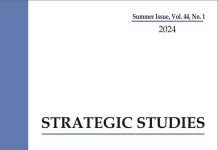Abstract
This article examines Sino-Indian power balancing in Nepal to explore Kathmandu’s policy options for security. Traditionally, both regional giants have sought to co-opt Nepal in a bid to outflank the other in the Himalayan region. India has exercised greater leverage profiting on ethnic and economic connections. Presently, China’s rise has offered Kathmandu a window of opportunity to substitute the Indian foothold in Nepal. China’s strategic leverage has increased due to the up-gradation of Sino-Nepalese political and economic connections. Nepal’s tilt towards Beijing has led New Delhi to seek reassurances from Kathmandu. Sino-Indian overlapping cultural and competing politico-strategic objectives has increased Kathmandu’s volatility to foreign intervention. The interplay of Sino-Indian regional balancing has constrained policy options for its security. Within this context, the article seeks to analyse the following questions: a.) What are Sino-Indian power ambitions and policy objectives in Nepal? b.) How has China’s expansion of influence impacted on Nepal-India relations and Kathmandu’s policy options for security? The theoretical cushion of neo-classical realism, employing qualitative techniques of content analysis has provided a befitting context to study Nepal’s security challenges. The article argues that Kathmandu’s security drive has to tread on a thin rope of power balancing caught in between India and China. Nepal balances between its tightly knit historic ties with India and the new opportunity dawned in building connections with Beijing. Nepal’s approach marks philosophical approach of Kautilya’s Raja Mandala as an expression of expedient move to win security.














